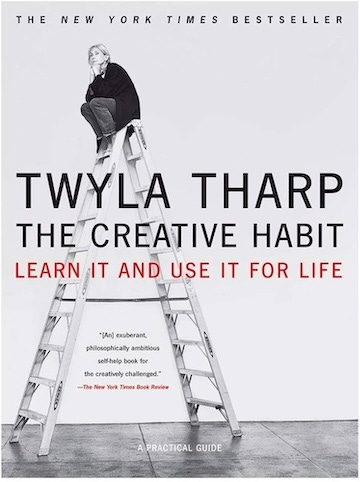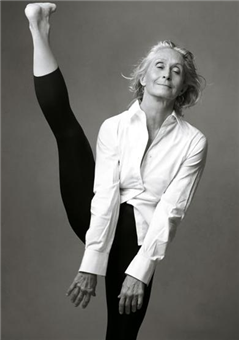5 Lessons from Twyla Tharp's The Creative Habit
How to be innovative in your art
Twyla Tharp is a legendary choreographer who has created scores of dances in her career. She has created dances for her own company, the Joffrey Ballet, The New York City Ballet, the Paris Opera Ballet, London’s Royal Ballet, and more. She’s won two Emmys and a Tony.
In other words, she knows what she’s talking about when it comes to creativity. And her book, The Creative Habit: Learn It and Use It for Life, has become a classic in that field.
There’s a lot in this book, so I’m just going to scratch the surface here.
Here are 5 lessons from The Creative Habit:
(Note: all quotes are from The Creative Habit, unless noted)
Embrace Failure
Every creative person has to learn how to deal with failure… If Leonardo and Beethoven and Goethe failed on occasion, what makes you think you’ll be the exception?
In her book, Tharp quotes the golfer Bobby Jones - “I never learned anything from a match I won.”
In other words, here on Earth School, we must fail in order to grow. It’s an inescapable part of life; in fact, it might be why we’re here. If we’re here to grow, then we must fail.
But it hurts and it’s not fun.
Many wonderful things come from failure. As Tharp writes, “ …there is a therapeutic power to failure. It cleanses. It helps you put aside who you aren’t and reminds you who you are.” Yes, and what could be more important than remembering who we are?
And then she adds, “Failure humbles.”
So, if we start getting into our heads - “Oh, I’m so great! Oh, everyone will love this piece!” - then here comes failure to bring us back into reality.
And in terms of making innovative, bold art, Tharp quotes the cliche, “If you’re not failing, you’re not taking enough risks.”
In other words, as David Bowie puts it, “If you feel safe in the area that you’re working in, then you’re not working in the right area. Always go a little further into the water than you feel like you’re capable of… Go a little bit out of your depth. And when you don’t feel that your feet are quite touching the bottom, you’re just about in the right place to do something exciting.”
So, if everything here is true, then isn’t failure actually success? And shouldn’t we be excited to fail? More failure equals more growth.
Perhaps “failure” needs to lose some of its negative connotations. Maybe there are cultures in which “failure” has only positive connotations? Or perhaps more words could be invented to describe different types of failure?
In any event, I’m going to do my best to start embracing failure, but it can be difficult for us perfectionists.
Habits Are Foundational
…routine is as much a part of the creative process as the lightning bolt of inspiration, maybe more.
So, we want to embrace failure, but at the same time, we don’t want our lives to turn into one big, endless fail. There’s a balance required for us to retain our sanity. So, how can we minimize failure?
A good part of Tharp’s answer to that question would involve habit. Her book is called The Creative Habit after all.
Her schedule is rigid; she wakes up every day at 5:30 AM and heads across town to work out - “I repeat the wake-up, the workout, the quick shower, the breakfast of three hard-boiled egg whites and a cup of coffee, the hour to make my morning calls… the two hours of stretching and working out ideas by myself… the rehearsals with the dance company, the return home in the late afternoon to handle more business details, the early dinner, and a few quiet hours of reading. That’s my day, every day. A dancer’s life is all about repetition.”
Not everyone needs to live with this level of intensity and rigidity, though, of course. Not all of us aim to be world-famous artists. But habits can still be our bedrock.
In my own life, as I watched my dad slip into dementia, I noticed that his habits, both good and bad, stayed with him until the end - his morning coffee and paper, his evening rum and coke, etc. Our habits are such an immense part of who we are.
Habit has fed Tharp’s productivity - she’s completed a considerable number of dances in her career. One effect of being prolific is that it can allow us to fail faster and thus grow faster.
And she points out that habits develop self-reliance - “My morning workout ritual… reminds me that, when all else fails, I can at least depend on myself.”
One last thought on the subject of habit - “... a philosophical tug of war will periodically rear its head. It is the perennial debate… between the beliefs that all creative acts are born of (a) some transcendent, inexplicable Dionysian act of inspiration… or (b) hard work. If it isn’t obvious already, I come down on the side of hard work… Creativity is a habit, and the best creativity is a result of good work habits. That’s it in a nutshell.”
Innovate!
The key is not to block yourself; you have to leave yourself open to everything.
Staying with the theme of habits a bit more, they are a foundation. And they are grounding. As our artistic imaginations soar wildly in the wind, they can always be tethered to the structure of habit.
So, if our goal as artists is to be true to ourselves and let our freak flags fly, that works best if those flags are fastened to a sturdy pole.
The parts of this book that really stuck with me are those where Tharp discusses how she generates new ideas and innovates - how she lets her freak flag fly.
The main approach she takes is improvisation -
It’s your one opportunity in life to be completely free, with no responsibilities and no consequences… It’s you alone, with no one watching or judging. If anything comes of it, you decide whether the world gets to see it. In essence, you are giving yourself permission to daydream during working hours.
There’s no tollbooth between my impulse and my action. I just do it and I consider the results, the consequences, and the truth (if any) later in repose. That’s an incredible place to be.
To improvise freely, we need to find a way to get out of our self-conscious minds.
She relates the fascinating way in which Edison used to do this - “When he needed an idea, Thomas Edison liked to sit in a ‘thinking chair’ holding a metal ball bearing in each palm… On the floor, directly under his hands, were two metal pie pans. Edison would close his eyes and allow his body to relax. Somewhere between consciousness and dreaming, his hands would relax and open without effort, letting the ball bearings fall noisily into the pie pans. That’s when he would wake up and write down whatever idea was in his head at that moment. It was his way of coming up with ideas without his conscious mind censoring them.”
More thoughts on how to escape the conscious mind can be found in my post on Rick Rubin in the section “Learn How to Assess Your Own Work.”
So, Tharp uses improvisation to escape her conscious mind, and gradually she collects little bits and pieces of ideas here and there. Eventually, she makes connections between some of these ideas, and the concept of a complete work starts forming.
Another method she uses to innovate is collaboration. Once she’s developed the concept, she must then work with dancers, lighting designers, and a variety of other professionals to bring the piece to life.
Not all art forms are inherently collaborative, though. But with a bit of creativity, I think we can all come up with ways to collaborate.
Another way to innovate is to explore new landscapes continuously - “I improvise in new rooms, turn on different music, change my reading habits, all in an effort to fight off old habits and shake myself up.”
And innovation can result from remaining open during the entire process of creation. So, once you’ve developed your concept and are ready to bring it to life, yes, you must prepare and plan. But you should also keep trying to remain open to new ideas and fortuitous mistakes - “This, to me, is the most interesting paradox of creativity: In order to be habitually creative, you have to know how to prepare to be creative, but good planning alone won’t make your efforts successful; it’s only after you let go of your plans that you can breathe life into your efforts.”
Use the George Harrison Trick
George Harrison once decided, as a game, to write a song based on the first book he saw at his mother’s house. Picking one up at random, he opened it and saw the phrase “gently weeps,” whereupon he promptly wrote his first great song, “While My Guitar Gently Weeps.”
I feel like this is pretty self-explanatory, and this post is getting a little long (my apologies!), so let’s move on…
Use the Hemingway Trick
Don’t drive yourself to the point of being totally spent. Try to stop while you have a few drops left in the tank, and use that fuel to build a bridge to the next day.
Tharp explains the Hemingway trick further, “Ernest Hemingway had the nifty trick of always calling it a day at a point when he knew what came next. He built himself a bridge to the next day… The Hemingway bridge is how you extend a mini-groove.”
She continues, “If you’ve been following a don’t-stop-till-you-drop routine - that is, you only quit when you’re totally wiped out - rethink that. This is how ruts form.”
When this happens for me - for example, let’s say I’ve started adding a synthesizer part to a song, and I know exactly what I want to do, but can’t finish it until the next day - my inner artist starts chomping at the bit! And the next day, I’m so energized and excited right off the bat!
It’s a great trick, and I intend to start exploring it much more seriously.
Do any of you use the Hemingway trick regularly? Any tips?



Yes, we can fail and learn and grow. Just don't give up. Keep hoping. Keep praying. Keep creating. God bless you
Some great advice here! I’m really trying to embrace the mistakes thing myself. When you do all aspects it’s easy to be the producer that just picks on every aspect of the project..